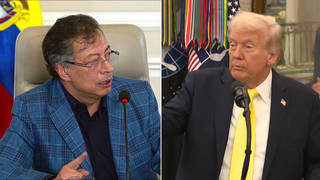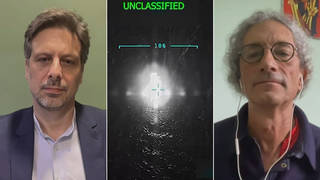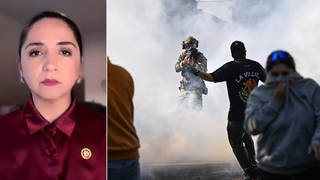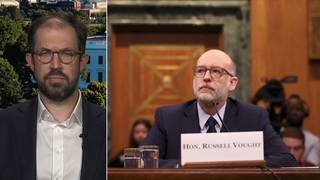
Topics
Guests
- Dahr Jamailstaff reporter at Truthout and author of The End of Ice: Bearing Witness and Finding Meaning in the Path of Climate Disruption.
Ongoing heavy rain has killed at least 67 people in Nepal, 25 in India and 14 in Bangladesh as flooding from monsoons has displaced 1 million people in South Asia. This year’s flooding in the region has been worse than ever before and is likely fueled by rising global temperatures, which have led to more extreme weather. Scientists warn that the risk of deadly floods is not over. In the United States, New Orleans residents managed to avoid the worst of Tropical Storm Barry, but 11 million people continued to be on flash flood warning as the storm slowly made its way through Louisiana over the weekend. President Trump has declared a state of emergency in Louisiana, where more than 60,000 remained without power on Sunday. We speak with Dahr Jamail, a staff reporter at Truthout and author of “The End of Ice: Bearing Witness and Finding Meaning in the Path of Climate Disruption.” “We can look around the world and just see, right now, before our very eyes, evidence of how deep in this crisis we already are,” says Jamail. “June was the hottest June ever recorded on the planet. The last five years are the hottest five years in history. This is the trajectory that we’re on, and these numbers are only going to continue to increase.”
Transcript
AMY GOODMAN: This is Democracy Now! I’m Amy Goodman. As Tropical Storm Barry made landfall in Louisiana, with millions of people under flash flood alert, an even more dire climate catastrophe was playing out across South Asia, where ongoing heavy rain and flooding have killed around a hundred people—67 people in Nepal, 25 in India, 14 in Bangladesh, monsoon rains displacing a million people, including thousands of Rohingya Muslim refugees in southern Bangladesh’s Cox’s Bazar—the largest refugee camp in the world. The flooding has also destroyed crops across the region. This is Mohammad Feroze Khan, an Indian farmer in Uttar Pradesh.
MOHAMMAD FEROZE KHAN: [translated] The rainfall has also been extreme, 70 to 72 hours of continuous rain. The water level kept increasing and slowly submerged the farmlands. Nearly all of the crops have been destroyed.
AMY GOODMAN: Monsoon season regularly pummels South Asia with deadly rains. Flooding killed more than a thousand people in 2017. But this year’s flooding has been even worse, is likely fueled by global warming, which has led to more extreme weather in the region. Scientists warn the risk of deadly floods is not over.
Here in the United States, New Orleans residents managed to avoid the worst of Tropical Storm Barry, but 11 million remain on flash flood warning after the storm slowly made its way through Louisiana, making its way to Arkansas. President Trump declared a state of emergency in Louisiana, where more than 60,000 people remained without power on Sunday. It was well over 100,000. And, of course, here in New York, you had this power outage of just a few hours, a city that is so heavily based on fossil fuel in the grid, though it is slowly changing under the city and state’s Green New Deal, encouraging buildings, even the skyscrapers, to have solar panels on their roofs.
For more, we go to Seattle to speak with Dahr Jamail, the independent journalist and author of The End of Ice: Bearing Witness and Finding Meaning in the Path of Climate Disruption, his most recent piece for Truthout headlined “Over One-Tenth of Global Population Could Lack Drinking Water by 2030.”
Dahr, welcome back to Democracy Now!
DAHR JAMAIL: Thank you, Amy.
AMY GOODMAN: Talk about what you think is most important to understand now, as we talk about the climate catastrophe that is enveloping us around the world.
DAHR JAMAIL: Well, the whole—everything we just heard about what you’re reporting with these ICE raids and the migrant crisis, the vast majority of these people are climate refugees. So, to anyone in this country that thinks this crisis is not just on our doorstep, but we’re living with the ramifications of it, that’s just one layer of it. We can look around the world and just see, right now, before our very eyes, evidence of how deep in this crisis we already are. It’s not a future-tense thing anymore. We are in it, and it is going to grow worse.
But even right now we saw regionally high temperature records across the Arctic for May. June was a record-hot June for Alaska. July 4th, Anchorage saw 90 degrees. We’re seeing feedback loops up there already kicked in, things like the tundra and the permafrost—the tundra, specifically, already becoming a net producer of carbon rather than a carbon sink.
If we look down to the Antarctic, sea ice there is melting at record rates. 2014, according to a recent study, was a record-high year of sea ice extent in Antarctica, the ice continent. In three years, by 2017, sea ice had reduced to its lowest level ever recorded, losing, in that short 3-year period, an area of ice larger than the size of the country of Mexico.
You were talking about the flooding in Asia. In addition to all the deaths you mentioned, in June, in Mumbai, in one 48-hour period, they received their average monthly rainfall in just one 48-hour period. These things are happening right in front of us. And I think that’s a very important part of this discussion that people need to understand and take in.
AMY GOODMAN: I want to turn to an interview last month Vice President Pence did, repeatedly refusing to say the climate crisis is a threat to the United States. He was interviewed by CNN’s Jake Tapper.
JAKE TAPPER: Do you think human-induced climate emergency is a threat to the United States?
VICE PRESIDENT MIKE PENCE: Well, what I will tell you is that we’ll always follow the science on that in this administration.
JAKE TAPPER: The science says—
VICE PRESIDENT MIKE PENCE: But what—but what we—
JAKE TAPPER: —it is.
VICE PRESIDENT MIKE PENCE: But what we won’t do—and the Clean Power Plan was all about that—was hamstringing energy in this country, raising the costs of utility rates for working families across this country.
JAKE TAPPER: But is it a threat?
VICE PRESIDENT MIKE PENCE: While other nations, like China and India, do absolutely nothing or make illusory promises decades down the road to deal with it. You know, the truth of the matter is, with the advent of—
JAKE TAPPER: Yeah.
VICE PRESIDENT MIKE PENCE: —natural gas, with the natural gas explosion that’s developing, with clean coal technology, we’re seeing—we’re seeing a significant reduction in carbon emissions all across this country.
JAKE TAPPER: But is what people are calling a climate emergency—is it a threat? Do you think it’s a threat, man-made climate emergency is a threat?
VICE PRESIDENT MIKE PENCE: I think the answer to that is going to be based upon the science.
JAKE TAPPER: But the science says yes.
VICE PRESIDENT MIKE PENCE: Well—
JAKE TAPPER: I’m asking you what you think.
VICE PRESIDENT MIKE PENCE: There’s many in the science that debate—
JAKE TAPPER: The science community, in your own administration, at NOAA—
VICE PRESIDENT MIKE PENCE: Yeah, I got it.
JAKE TAPPER: —at the DNI, they all say it’s a threat.
VICE PRESIDENT MIKE PENCE: I got it. Look, what the president has said—
JAKE TAPPER: But you won’t, for some reason.
VICE PRESIDENT MIKE PENCE: What we’ve said is that we are not going to raise utility rates.
JAKE TAPPER: So, you don’t think it’s a threat, is all I’m saying. You don’t think it’s a threat.
VICE PRESIDENT MIKE PENCE: I think we’re making great progress reducing carbon emissions. America has the cleanest air and water in the world. We’ll continue to use market forces to advance—
JAKE TAPPER: It’s not true. We don’t have the cleanest air and water in the world.
VICE PRESIDENT MIKE PENCE: I think—
JAKE TAPPER: We don’t, according—I mean—will you get back to me with some statistics and show us?
VICE PRESIDENT MIKE PENCE: But we’re making—we’re making progress on reducing carbon omissions.
AMY GOODMAN: There is the vice president of the United States refusing to say climate change—that the climate crisis is a threat. Your response, Dahr Jamail, as he says you have to look at the science?
DAHR JAMAIL: Well, it’s certainly not a surprise that these fossil fuel stooges of this administration would react exactly as Pence just did. I mean, they have their talking points, they have their marching orders, and they’re just simply executing them. Meanwhile, if we look around the world at what’s happening, again, the evidence is right in front of our face.
You know, there’s so many Native American stories that have talked about what happens when we do not live in harmony with Mother Nature, and what happens if we get out of balance with that. One of them that I’ve written about and discussed is a story from the Pit River Nation, told by Darryl Wilson of the Pit River Nation of northeastern California. And just as an example, he talks about a spirit force called Mis Misa that lives inside of Akoo-Yet, the mountain that white people named Mount Shasta. And as long as humans listen very carefully and comport themselves correctly towards that mountain and listen to that spirit voice, nature will be kept in balance. But if people stop listening altogether, and if enough people stop listening, then that spirit force, Mis Misa, will go away and stop singing, and everything on the planet will go out of balance, and life therein vulnerable to extinction. And that’s just one of countless stories and prophecies that warned of exactly what is upon us.
We, industrialized humans, have stopped listening to the planet. We’ve stopped living in harmony. And now we’re living in a time of reckoning of that. And unfortunately, if we look at all of the science, this is just the beginning. Everything that we’re seeing, everything that everybody knows about the climate crisis to date, has happened from just raising the temperatures 1.1 C above preindustrial baseline levels. We are looking at temperature escalations in the coming years—not even talking about 2100, but even by 2050—that we could see several times that amount of increase, according to some of the most dire scientific predictions.
AMY GOODMAN: Dahr—
DAHR JAMAIL: And so, we—sorry. Go ahead. Amy.
AMY GOODMAN: I wanted to say, a senior State Department intelligence analyst has recently resigned in protest after the Trump administration blocked parts of his written testimony to Congress about the dangers of climate change. In June, analyst Rod Schoonover was permitted to appear before the House Intelligence Committee to testify about the national security risks posed by global warming, but the White House barred him from submitting peer-reviewed scientific journal articles and intelligence reports as evidence to back his claims. Part of his censored testimony to Congress read, quote, “Absent extensive mitigating factors or events, we see few plausible future scenarios where significant—possibly catastrophic—harm does not arise from the compounded effects of climate change.” Catastrophic harm. But he wasn’t allowed to say this to Congress.
And I want to talk about some of those just catastrophic harms. One of those, which you most recently wrote about for Truthout, “Over One-Tenth of Global Population Could Lack Drinking Water by 2030.” Tell us what you found.
DAHR JAMAIL: Right. That’s according to studies and warnings coming out of the country of India, where literally half the population of the entire country is on track, if things do not change—and, clearly, things are changing, but unfortunately for the worse—but on the current trajectory, by 2030—we’re talking barely over 10 years from right now—half the country of India is likely going to be facing not having enough drinking water. You know, the bigger translation of that, that’s one-tenth the global population. That’s on top of people already today that lack enough drinking water, on top of the fact that the U.N. is warning of tens of millions more climate refugees just in the next decade alone.
You know, we talk about these catastrophic effects. One of these is children in cages. It’s what the whole first half of the show was just on. I mean, these changes are right in front of our face. And so, when the Trump administration talks about, “Well, you know, we’re going to use our scientists, and we’re going to rely on science,” well, you know, this is a fossil fuel lobby talking point that they’re following. If we look at all of the other science around the world, and even, save the science, if we just use our own eyes and look at these events unfolding right in front of us, it’s very, very clear.
Now, Amy, when I published my recent book, this is the result of nine years of intensive climate reporting and of meticulous research. And I went into the field, and I went to the front lines with leading scientists and saw with my own eyes what is happening. And everything that I found is right there. And I didn’t even know how right that I had it. And what we’re seeing playing out in front of us, though, now is so accelerated and so much faster than I thought, even when the book came out, that I am shaking my head on a daily basis as I write these ongoing climate dispatches. And so, it is a situation where this is likely my last journalism book, because on this crisis, the evidence is in front of us. We keep reporting the same stories over and over. We just keep adjusting the numbers upwards. And like we always used to hear when we were reporting from Iraq about how bad things were becoming there, today is better than tomorrow. And that certainly applies to the climate crisis. June was the hottest June ever recorded on the planet. The last five years are the hottest five years in history. This is the trajectory that we’re on, and these numbers are only going to continue to increase.
AMY GOODMAN: And then talk about who it affects. A U.N. expert has warned we’re on track for a climate apartheid, where wealthy people can pay their way out of the consequences of climate devastation, while others will face hunger, conflict, mass displacement. The new report is by Philip Alston, the U.N. special rapporteur on extreme poverty and human rights, concluding the U.N. and the larger human rights community has been complacent in the planet’s impending disaster, and that even if current global emissions targets are met, millions will be impoverished, poorer nations expecting to bear at least 75% of the costs of climate change, even as the poorer half of the world’s population generates just 10% of global emissions. Dahr?
DAHR JAMAIL: Right. I believe the numbers from that report are 120 million more people driven into poverty by climate impacts by just 2030. And that’s on top of the people that are already there. Again, the evidence—you know, we just spent—you just spent 30 minutes reporting on the evidence and talking to these poor people who are fleeing their countries because they do not have food. They cannot grow crops. The support in their own countries to help them through this crisis, to help them find another way of living, even just basic necessities like food, shelter and healthcare, is not there. These people are risking their lives to go to a completely different country to try to find help.
And think about it. Here in the U.S., so many of us live in this bubble where we, at least for now, have enough food and water, and something like healthcare, if we’re lucky. How bad would things have to get for each one of us to leave everything that we know and love, places where we’ve spent large parts of our lives, and go to a completely new foreign country, especially one that we know hates us and rejects us, and the government is demonizing us and going to great lengths to keep us out—
AMY GOODMAN: We have five seconds.
DAHR JAMAIL: —and, if we manage to get in, is going to terrorize us and kick us out? That’s how bad it is for people living in poverty already.
AMY GOODMAN: Well, Dahr Jamail, we want to thank you for being with us. We’re going to go with you to Part 2, and we’ll post it online at democracynow.org. Dahr Jamail’s new book, The End of Ice: Bearing Witness and Finding Meaning in the Path of Climate Disruption. We’ll link to your piece, “Over One-Tenth of Global Population Could Lack Drinking Water by 2030.”











Media Options